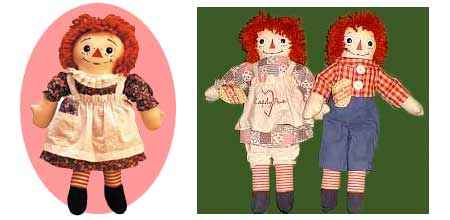Raggedy Ann

Synopsis of Toy
Though Raggedy Ann is a perennial favorite for kids and collectors, this wildly successful and well-loved doll wasn’t dreamed up in any toy company’s R&D department. According to the lore that surrounds her, Ann's modest and poignant beginnings took place on a rainy day, when a little girl plucked her out of the damp cold in her grandmother’s attic, and then showed off her new toy to her cartoonist father. Of course, lore tends to get soaked in melodrama and stretches-of-the-truth—nowadays, the story’s rainy weather is in question, and the location of said attic is in question. Heck, even the identity of who really found the doll in said attic is in question…but let’s not get caught up in the technicalities.
The cartoonist father was Johnny Gruelle, who had been a political cartoonist and a freelance illustrator for other writers’ cartoon strips. When, as the story goes, his daughter Marcella burst into his art studio carrying the soiled, faceless rag doll she had found, Gruelle picked up a pen and drew in her facial features and suggested that Marcella’s grandma might be able to sew on buttons as eyes. Then, he opened a nearby book of James Whitcomb Riley’s poetry and concocted the doll’s name from two poems: “The Raggedy Man” and “Little Orphan Annie.” Sadly, a few years later, Marcella died of an infected smallpox vaccination—she was thirteen. Gruelle, who was working on several versions of illustrated fairy tales and playtime yarns already, now focused on his nascent “Raggedy Ann” stories—the very stories that some say he told to his little girl in the last days of her illness.
When Gruelle’s stories were published as the Raggedy Ann Stories in 1918, the book’s protagonist was named after his late daughter, and she would be a reoccurring character in the twenty-five books that followed. Gruelle believed that children’s books “should contain nothing to cause fright, suggest fear, glorify mischief, excuse malice or condone cruelty.” The folksy and wholesome Raggedy Ann, with her candy heart and her brother named Andy, became a spokesdoll for trust and kindness, for always doing the moral thing. The two dolls' caregiver, Beloved Belindy, Camel with the Wrinkled Knees, Quacky Doodles and Danny Doodles—characters just as cheerful and kindly as the Ann and Andy—later joined the rag doll duo.
Another part of Raggedy Ann legend is that Gruelle and his family manufactured the first dolls—to accompany the new book’s release. Whether the family actually made the doll’s first prototypes or just held (and continue to hold onto today) the first Raggedy Ann patent is a detail that’s up for grabs—to be determined by whoever is telling the Raggedy Ann story. The first toy company, and now we’re back to fact, to make the dolls was called P.F. Volland. Exposition Doll and Toy Manufacturing had a go in 1935, and then Knickerbocker after that. Today, Simon and Schuster retain Raggedy Ann and Andy literary rights, and Hasbro-Playskool and Applause Toy Company hold the license to the characters for toys and merchandise.
The Knickerbocker dolls, which were introduced in the 1960’s, were dressed in nostalgic gingham and calico fabrics, had cloth bodies, red and white striped legs, and an “I love you” message printed over their hearts. The Applause Toy Company started as a division of Knickerbocker in 1979, and the bulk of their dolls had embroidered faces, though there was one version with button eyes—just like Marcella’s original doll. The Ideal Company made a set of 18" porcelain dolls in 1978, to coincide with the release of the animated Raggedy Ann and Andy musical movie. This was the dolls’ least soft and cuddly phase—renowned, as they are, for their huggable, all-cloth bodies. Hug some of the dolls hard enough, in fact, and you might be able to feel Ann’s magic pebble or Andy’s wishing stick inside, which were both ornaments from the duo’s storybook days.
Raggedy Anns and Andys are widely, widely collected, and though they’re steeped in old-time Americana, they have legions of adoring fans in other countries. Aside from the books and the dolls, Raggedy products range from wallpaper to tea sets to comics to doll house miniatures. There aren’t many toy personalities this durable, and there certainly aren’t many toys with such a frequently retold and refashioned legacy.
Release History of Toy
1962 - Knickerbocker cloth dolls1995 - recreation of Johnny Gruelle's early patent design
